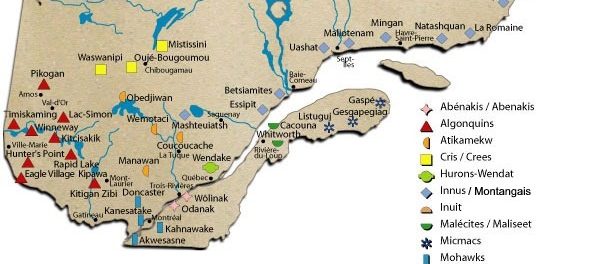Quebec’s Aboriginals, Part II & Other Quebec Curios
Quebec’s aboriginal community counts eight Algonquian, two Iroquois communities, and the Inuit. On this week’s edition of Curios, we take a look at another four communities and their cultures.
Cree (Algonquian)
Prior to the arrival of the European explorers in the 1600s, the Cree were a people that lived a small family called a “lodge”, consisting of two families, and hunted in “bands”, groups of families that hunted and gathered together. The Cree was and remains one of the largest in the province and in North America; Quebec’s Cree are called the James Bay Cree. They largely have settled in the west of Quebec. The Quebec Cree have the following communities: the Chisasibi, Eastmain, Mistissini, Nemaska, Oujé-Bougoumou, Waskaganish, Waswanipi, Wemindji, and the Whapmagoostui. Population today: about 16,960.
Inuit
Not to be confused with the Innu, an Algonquian tribe, the Inuit community is not part of the ten First Nations community as the Inuit are their own indigenous group with a different language, customs, and traditions from their First Nations cousins. Their lives came in contact with explorers at different points in time, at one point having peaceful trade with Norse explorers. While largely isolated from the violence of the French and Indian War, the Inuit were disturbed by the arrival of the European explorers who wanted to exploit the whaling possible in their territory. In the The Inuit community of Quebec, while not the largest aboriginal community, rank among one of the most populous people. Their communities are at the very north of Quebec, on the shorelines around the Hudson Bay and the Ungava Bay. There are fourteen communities in the province: the Akulivik, Aupaluk, Inukjuak, Ivujivik, Kangiqsualujjuaq, Kangiqsujuaq, Kangirsuk, Kuujjuaq, Kuujjuarapik, Puvirnituq, Quaqtaq, Salluit, Taiujaq, and the Umiujaq. Population today: about 11,318.
Innu (Algonquian)
Also known as the Montagnais or the Naskapi people, depending on the location from which they came, the Innu people are close relatives of the Cree that settled in the northern parts of Quebec and Newfoundland. An initially nomadic tribe, the traditional Innu way of life was disrupted by the beginnings of the fur trade industry and even more upset by the forced settlement system set up in the twentieth century. Prior to contact with the Europeans, the Innu had a system of religion based on the respect of animals and their diet consisted of food that they could hunt or fish. Today, the Innu live in communities north of Montreal island. The communities that live in Quebec are the Essipit, Mashteuiatsh, Matimekosh, Minigan, Natashquan, Paskuashipi, Pessamit, La Romaine, and the Uashat-Maliotenam. Population today: about 16,822.
Maliseet (Algonquian)
The Maliseet people called themselves the Wolastoqiyik, meaning “people of the beautiful river” (referring to Saint John River in New Brunswick). However, local Mi’kmaq people named them the Maliseet (Algonqin for “he speaks badly”). The Europeans who came into contact with the Wolastoqiyik people thus named them the Maliseet, and the name stuck. The Maliseet of Quebec settled near the Saint Laurence river, and have only one community, the Viger community, near Cacouna, Quebec. Population today: about 788.






